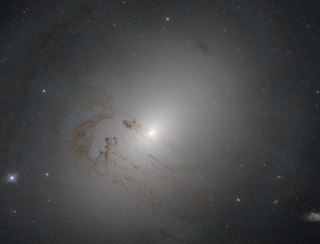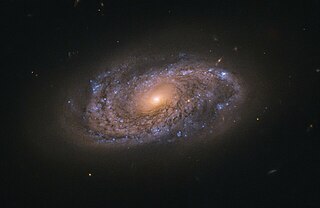
The M81 Group is a galaxy group in the constellations Ursa Major and Camelopardalis that includes the galaxies Messier 81 and Messier 82, as well as several other galaxies with high apparent brightnesses. The approximate center of the group is located at a distance of 3.6 Mpc, making it one of the nearest groups to the Local Group. The group is estimated to have a total mass of ×1012M☉. The M81 Group, the Local Group, and other nearby groups all lie within the Virgo Supercluster.

The Pinwheel Galaxy is a face-on spiral galaxy located 21 million light-years from Earth in the constellation Ursa Major. It was discovered by Pierre Méchain in 1781 and was communicated that year to Charles Messier, who verified its position for inclusion in the Messier Catalogue as one of its final entries.

NGC 1566, sometimes known as the Spanish Dancer, is an intermediate spiral galaxy in the constellation Dorado, positioned about 3.5° to the south of the star Gamma Doradus. It was discovered on May 28, 1826 by Scottish astronomer James Dunlop. At 10th magnitude, it requires a telescope to view. The distance to this galaxy remains elusive, with measurements ranging from 6 Mpc up to 21 Mpc.

NGC 3432 is an edge-on spiral galaxy that can be found in the northern constellation of Leo Minor. It was discovered by German-British astronomer William Herschel on March 19, 1787. This galaxy is located at a distance of 40 million light-years (12.3 Mpc) from the Milky Way. It is interacting with UGC 5983, a nearby dwarf galaxy, and features tidal filaments and intense star formation. Because of these features, it was listed in Halton Arp's Atlas of Peculiar Galaxies.

NGC 936 is a barred lenticular galaxy in the constellation Cetus. It is at a distance of about 60 million light-years away from Earth. Its nucleus and prominent bar have high surface brightness. Because of the shape of the prominent bar, the nucleus and the ring of stars at the end of the barrel, the galaxy has been compared with the shape of a TIE fighter, from the Star Wars universe, and thus NGC 936 has been named Darth Vader’s Galaxy or Darth Vader’s Starfighter. By measuring the radial velocity of the disc, Kormendy found in 1986 that the disc is stable, which is the reason why it is so smooth.

NGC 2655 is a lenticular galaxy in the constellation Camelopardalis. It is at a distance of 60 million light years from Earth. NGC 2655 is a Seyfert galaxy. The galaxy has asymmetric dust lanes in the centre of the galaxy, tidal arms and extended neutral hydrogen gas and may have recently experienced a merger. The complex dynamics of the HI and optical tails suggest the galaxy may have undergone more mergers in the past. A weak bar has been detected in infrared H band. The diameter of the disk of the galaxy is estimated to be 60 Kpc.

NGC 4026 is an edge-on lenticular galaxy in the constellation Ursa Major. It is located at a distance of circa 50 million light years from Earth, which, given its apparent dimensions, means that NGC 4026 is about 80,000 light years across. It was discovered by William Herschel on April 12, 1789.

NGC 4753 is a lenticular galaxy located about 60 million light-years away in the constellation of Virgo. NGC 4753 was discovered by astronomer William Herschel on February 22, 1784. It is notable for having distinct dust lanes that surround its nucleus. It is a member of the NGC 4753 Group of galaxies, which is a member of the Virgo II Groups, a series of galaxies and galaxy clusters strung out from the southern edge of the Virgo Supercluster.

NGC 2280 is a spiral galaxy located in the constellation Canis Major. It is located at a distance of circa 75 million light years from Earth, which, given its apparent dimensions, means that NGC 2280 is about 135,000 light years across. It was discovered by John Herschel on February 1, 1835. One supernova has been observed in NGC 2280, SN 2001fz, a type II supernova discovered by the Beijing Astronomical Observatory Supernova Survey on November 15, 2001. It had a peak magnitude of 17.4.

NGC 5965 is a spiral galaxy located in the constellation Draco. It is located at a distance of circa 150 million light years from Earth, which, given its apparent dimensions, means that NGC 5965 is about 260,000 light years across. It was discovered by William Herschel on May 5, 1788.

NGC 1380 is a lenticular galaxy located in the constellation Fornax. It is located at a distance of circa 60 million light years from Earth, which, given its apparent dimensions, means that NGC 1380 is about 85,000 light years across. It was discovered by James Dunlop on September 2, 1826. It is a member of the Fornax Cluster.

NGC 877 is an intermediate spiral galaxy located in the constellation Aries. It is located at a distance of circa 160 million light years from Earth, which, given its apparent dimensions, means that NGC 877 is about 115,000 light years across. It was discovered by William Herschel on October 14, 1784. It interacts with NGC 876.

NGC 973 is a giant spiral galaxy located in the constellation Triangulum. It is located at a distance of circa 200 million light-years from Earth, which, given its apparent dimensions, means that NGC 973 is about 230,000 light years across. It was discovered by Lewis Swift on October 30, 1885.

NGC 3656 is a peculiar galaxy formed by the collision of two galaxies in the constellation of Ursa Major. It is located about 135 million light years away from Earth, which means, given its apparent dimensions, that NGC 3656 is approximately 70,000 light years across. It was discovered by William Herschel on April 14, 1789.

NGC 2906 is a spiral galaxy located in the constellation Leo. It is located at a distance of circa 120 million light years from Earth, which, given its apparent dimensions, means that NGC 2906 is about 75,000 light years across. It was discovered by William Herschel on December 28, 1785.

NGC 4589 is an elliptical galaxy located in the Draco constellation. It is at a distance of about 108 million light-years away from the Earth. It is known by its designations PGC 42139 or UGC 7797.

NGC 4747 is a barred spiral galaxy located in the constellation Coma Berenices. It is located at a distance of about 35 million light years from Earth, which, given its apparent dimensions, means that NGC 4747 is about 35,000 light years across. It was discovered by William Herschel on April 6, 1785. It is included in the Atlas of Peculiar Galaxies in the interior absorption category.

NGC 2445 is a peculiar ring galaxy in the constellation Lynx. The galaxy lies about 200 million light years away from Earth, which means, given its apparent dimensions, that NGC 2445 is approximately 100,000 light years across. It was discovered by Édouard Stephan on January 18, 1877. The galaxy interacts with another galaxy, NGC 2444, and as a result its shape is distorted and new stars are formed.

NGC 2444 is a peculiar lenticular galaxy in the constellation Lynx. The galaxy lies about 135 million light years away from Earth, which means, given its apparent dimensions, that NGC 2444 is approximately 50,000 light years across. It was discovered by Édouard Stephan on January 18, 1877. The galaxy interacts with another galaxy, NGC 2445, whose shape is distorted and has large star formation regions.

NGC 4670 is a blue compact galaxy in the constellation Coma Berenices. The galaxy lies about 60 million light years away from Earth, which means, given its apparent dimensions, that NGC 4670 is approximately 25,000 light years across. It was discovered by William Herschel on April 6, 1785.




















